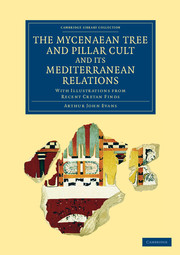
- Publisher:
- Cambridge University Press
- Online publication date:
- October 2014
- Print publication year:
- 2013
- First published in:
- 1901
- Online ISBN:
- 9781139794862
Last updated 10th July 2024: Online ordering is currently unavailable due to technical issues. We apologise for any delays responding to customers while we resolve this. For further updates please visit our website https://www.cambridge.org/news-and-insights/technical-incident


Sir Arthur John Evans (1851–1941), the pioneer of ancient Cretan archaeology, most famously excavated the ruins of Knossos and uncovered the remains of its Bronze Age Minoan civilisation (as detailed in The Palace of Minos at Knossos, also reissued in this series). In this highly illustrated work, first published in 1901, Evans surveys the recent archaeological evidence from his dig at Knossos as well as from other locations around the Mediterranean. He describes a variety of religious objects and symbols, especially those concerned with sacred stones, pillars and trees, which Evans argues are characteristic of religious worship in the Mycenaean period. He considers in particular the importance of the Cretan double-axe symbol, the labrys, its close link with depictions of bulls and its association with the labyrinth of Knossos. Elsewhere he examines the symbolism of the Lion Gate at Mycenae and finds parallels with similar artefacts found in Crete and Egypt.
 Loading metrics...
Loading metrics...
* Views captured on Cambridge Core between #date#. This data will be updated every 24 hours.
Usage data cannot currently be displayed.